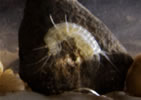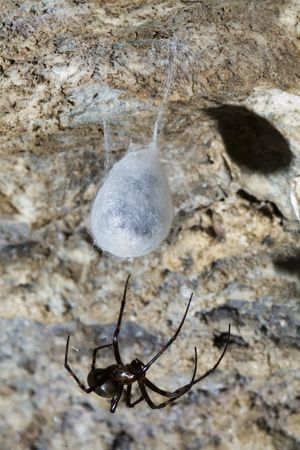 |
Cave Life of Devon |
 |
| |
| HOME |
| INTRODUCTION |
| LIFE IN THE ENTRANCE |
| LIFE IN THE CAVE |
| CONSERVATION |
| GLOSSARY |
| ACKNOWLEDGEMENTS |
| Bacteria |
| Fungi |
| Plants, Algae & Protozoans |
| Flatworms |
| Eelworms & Segmented Worms |
| Slugs & Snails |
| Crustacea |
| Insects |
| Spiders & Millipedes |
| Fish & Amphibians |
| Birds |
| Bats |
| Fossils and archeology |
| |
Life in the cave - Spiders and millipedes |
||||||||
Meta menardi is a large, dark brown, troglophilic cave spider that is well known to cavers. They are orb web spinning spiders and spin the characteristic spider web to help catch prey. Meta spiders need space to create these webs, which are not spun across the cave passage like normal orb spiders unless there is nothing else to anchor the web to. The threads of the web of Meta menardi are not sticky and appear to serve as a supportive platform for the spider rather than directly serving to trap prey, instead the radial threads act as a series of trip lines to detect the presence of potential prey on the cave walls and ceiling. They feed on woodlice, millipedes, slugs, earthworms, flies (Culex pipiens in particular) and possibly smaller Meta menardi (although there is no evidence of this). It can gorge itself and may store food by trussing it in the web.
Metellina (formerly in the genus Meta) merianae is found in the threshold, often at the entrance itself where it spins an orb web to catch creatures flying in and out of the cave. It is a similar shape to M. menardii, but is smaller and brown and grey in colour. It is generally found in the shallow threshold zone, whilst Meta menardi is often found deeper in the cave. The two species are frequently recorded from the same caves.
Mites are small relatives of spiders. There are a number of mites found living in Devon caves, including members of the genera Eugasmus and Rhagidia, Hirstesia sternalis (Baker’s Pit) Cyrtolaelaps mucronatus (Bickington Pot), Belba pulveruleuta, (Chudleigh Cavern), Ameroseius corbicula (Levaton Cave) , Clayptostoma velutinus (Levaton and Rift caves), Nycteribia biarticulata (Pixies Hole), Euzetes globulus (Rift Cave) and Euzetes seminulum (Rift and Ware caves) Centipedes are normally regarded as soil organisms and there have been few recordings from caves, with most of these being in Devon. They are predators feeding on nematodes, mites and other smaller insects. The most common species that might be encountered is Lithobius dubosqui (Baker’s Pit and Napp’s), a small, rather short-bodied species that might be regarded as a possible cavernicole. Other species that have been recorded (generally in the threshold) include Lithobius forficatus (West Ogwell Cave) Strigamia crassipes (Great Rock Mine) and Geophilus electricus (Napp’s). The Symphyla are slightly larger centipede-like white organisms that also live on dead plant matter in soil. Symphylella isabellae can be found in caves, sometimes far into the dark zone.
Millipedes are more common with a number of cavernicole species, some of which are blind. Millipedes feed on plant debris including wood and are particularly common in oak woodlands on limestone, living for several years. Cave forms often have a thinner shell and more sensory bristles than those on the surface. The two species most frequently recorded in Devon caves are Blaniulus guttulatus and Nanogona polydesmoides (formerly Polymicrodon polydesmoides), both of which occur in the dark zone and can be considered cavernicolous. Other species include Brachydesmus superus (Torr Bridge Cave), Tachypodoiulus niger (Kitley Rift Cave, Reeds Cave and Napps Cave) and Polydesmus sp.
|

.jpg)
.jpg)
.jpg)